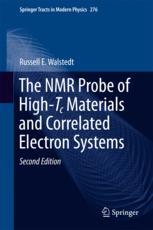

Most ebook files are in PDF format, so you can easily read them using various software such as Foxit Reader or directly on the Google Chrome browser.
Some ebook files are released by publishers in other formats such as .awz, .mobi, .epub, .fb2, etc. You may need to install specific software to read these formats on mobile/PC, such as Calibre.
Please read the tutorial at this link. https://ebooknice.com/page/post?id=faq
We offer FREE conversion to the popular formats you request; however, this may take some time. Therefore, right after payment, please email us, and we will try to provide the service as quickly as possible.
For some exceptional file formats or broken links (if any), please refrain from opening any disputes. Instead, email us first, and we will try to assist within a maximum of 6 hours.
EbookNice Team

Status:
Available4.5
35 reviewsThis new edition updates readers in three areas of NMR studies, namely, recent developments in high-Tc materials, heavy fermion systems and actinide oxides are presented. The NMR probe has yielded a vast array of data for solid state materials, corresponding to different compounds, ionic sites, and nuclear species, as well as to a wide variety of experimental conditions. The last two parts of the book are completely new in this edition, while the first part has seen major updates.This edition features the latest developments for high-Tc materials, especially the advances in the area of pseudogap studies are reviewed. An in depth overview of heavy fermion systems is presented in the second part, notably Kondo lattices, quantum critical points and unconventional superconductivity are areas of intense research recently and are covered extensively. Finally, valuable information from NMR studies with actinide oxides will be provided.Ongoing analysis and discussion of NMR data have resulted in a wealth of important insights into the physics of these exotic systems. The aims of this monograph are manyfold. First, it reviews NMR methodology as it has been applied to the different studies. This is addressed to NMR practitioners and to physics laypersons alike. Next, it presents a review of NMR measurements and the wide variety of phenomena which they represent. The third phase is to recount the theoretical model calculations and other proposals which have been put forward to account for these data.